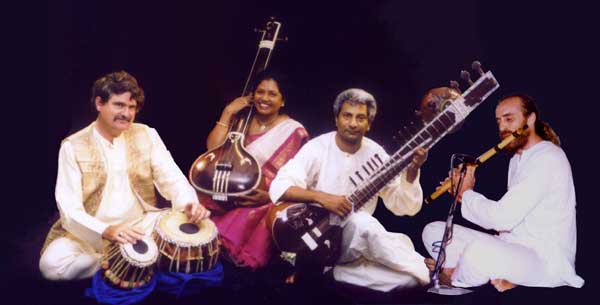INDIAN INSTRUMENTS

There are many musical instruments in India. Some instruments are used primarily in north Indian music (Hindustani sangeet), some are used in the south Indian music (Carnatic sangeet), while others are found in folk music. Instrumental music is usually similar to vocal music but sometimes there are distinctive instrumental styles.
There is a traditional system for the classification of instruments. This system is based upon; non-membranous percussion (ghan), membranous percussion (avanaddh), wind blown (sushir), plucked string (tat), bowed string (vitat). Here are the classes and representative instruments.
NON-MEMBRANOUS PERCUSSIVE (Ghan)
This is one of the oldest classes of instruments in India. This class is based upon percussive instruments which do not have membranes, specifically those which have solid resonators. These may be either melodic instruments or instruments to keep tal.
BLOWN AIR (Sushir)
This class of instrument is characterized by the use of air to excite the various resonators.
PLUCKED STRINGED INSTRUMENTS (Tat)
This class of instruments is characterized by plucked strings. In ancient times virtually all instruments of this class were referred to as vina.
- Sitar
- Rabab (Kabuli Rabab)
- Sarod
- Saraswati Vina (South Indian Vina)
- Surbahar
- Gotuvadyam
- Rudra Vina
- Vichitra Vina
- Ektar
- Tanpura
- Dotar
- Santur
- Surmandal
- Bulbul Tarang
- Nakula Vina
- Magadi Vina
- Getchu Vadyam (Gettuvadyam)
- Gopichand (ektar)
- Seni Rabab
BOWED-STRINGED INSTRUMENTS (Vitat)
This is a class of stringed instruments which are bowed. This class appears to be quite old, yet these instruments did not occupy a place in classical music until the last few centuries. The entire class of instruments has a certain stigma attached to it. Even today only the Western violin is free of this stigma.
MEMBRANOUS PERCUSSIVE (Avanaddh)
This is a class of instruments which have struck membranes. These typically comprise the drums.
- Tabla
- Pakhawaj
- Mridangam
- Tabla Tarang
- Dholak
- Nagada
- Dholki (Nal)
- Daf (Duf, Daphu, Daffali)
- Kanjira
- Tavil
- Khol (Mridang)
- Pung
- Thanthi Panai
- Damaru
- Chenda
- Shuddha Madalam
- Idakka and Udaku (Udakai)
We have given a brief overview of the Indian instruments. We mentioned that the instruments fall into five categories: ghan (non-membranous percussion), sushir (wind blown), tat (plucked stringed), vitat (bowed stringed) and avanaddh (membranous percussion). Within these five classes there are a large number of individual instruments.